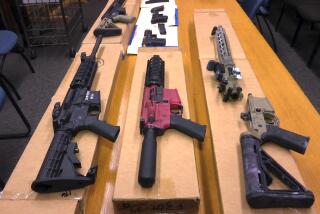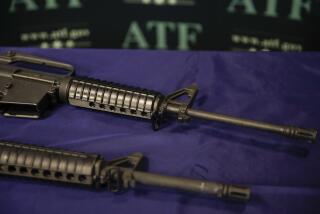Smith & Wesson Draws a Bead on Reform
- Share via
In a breakthrough in our efforts to reduce gun violence and prevent accidental shootings, Smith & Wesson, the nation’s largest gun manufacturer, on Friday agreed to implement comprehensive safety and distribution reforms.
This agreement is the culmination of a collaborative effort by the Clinton administration, states that have threatened to bring lawsuits against the gun industry and the counties and cities, such as Los Angeles, that already have filed suit. We joined forces to demand fundamental changes in the way guns are designed, distributed and advertised. This agreement will serve as a model for the gun industry and as the standard for future settlements.
For the record:
12:00 a.m. March 23, 2000 For the Record
Los Angeles Times Thursday March 23, 2000 Home Edition Metro Part B Page 9 Letters Desk 1 inches; 25 words Type of Material: Correction
Gun pact--Smith & Wesson has agreed to electronic tracking of all guns it sells. The extent of the agreement was misstated in a March 19 commentary by Andrew Cuomo and James K. Hahn.
For decades, the gun industry refused to make guns safer, claiming impracticality or impossibility. Smith & Wesson has stepped forward and demonstrated clearly and convincingly that there is no barrier--technological or otherwise--to making guns safer.
Under the agreement, for example, Smith & Wesson will now design guns that cannot be operated by young children. Had this feature already been in place on all guns, the recent tragic shooting by a 6-year-old may well have been prevented. Children who find guns in the home also will be protected by Smith & Wesson’s agreement to almost immediately sell guns with an external lock and to place internal locks on new guns within two years.
To prevent a user from inadvertently firing a gun under the mistaken impression that a gun is unloaded--an occurrence which results in approximately 23% of accidental shootings--Smith & Wesson will place an indicator on its pistols alerting users that a bullet is in the chamber.
Perhaps most significant, Smith & Wesson has agreed to commit 2% on its annual firearms sales revenue to the development of personalized gun technology and, within three years, to incorporate this technology into all new firearms designs. With this technology, a gun only could be operated by its lawful purchaser and be useless to criminals who purchase guns on the illegal secondary market or steal their weapons. It will also allow parents to prevent their children from accidentally firing such weapons.
These design features are important in themselves and also show a new willingness on the part of the industry to take its fair share of responsibility for gun safety.
The safety and design concessions go hand-in-hand with important changes in how guns will be sold. Up to now, many gun manufacturers have asserted that once their product leaves their factories, they simply have no responsibility for what happens. Smith & Wesson reversed this position by agreeing to sell only to dealers who comply with stringent controls, including undergoing extensive training to recognize and prevent straw purchases of guns and meeting strict security and insurance requirements, as well as implementing an electronic inventory system to track the weapons sold at the show. Smith & Wesson has further agreed not to market guns in a way that appeals to juveniles and won’t advertise their products near schools, high-crime areas or public housing.
Going beyond what federal law now requires, the agreement closes the gun-show loophole by providing that Smith & Wesson will only sell to gun shows that agree to conduct background checks on all the guns they sell. And for the first time, purchasers must complete a certified safety training course or have passed a certified firearms safety exam.
In the past, the gun industry has also asserted that it was not its responsibility to reduce the use of guns in crime. With this agreement, Smith & Wesson rejects this position and will begin test-firing all of its handguns in order to allow the “finger-printing” of guns to assist law enforcement. An oversight commission, made up of representatives of cities, states, Smith & Wesson and the Bureau of Alcohol, Tobacco and Firearms, will monitor retailers to ensure that their guns are not disproportionally traced to crime.
This agreement sends a historic, yet simple, message. We can accomplish so much more through cooperation and negotiation than we can through confrontation and denigration. Smith & Wesson has shown that good business practices are compatible with corporate responsibility, and we urge the rest of the gun industry to adopt the model set by Smith & Wesson.


